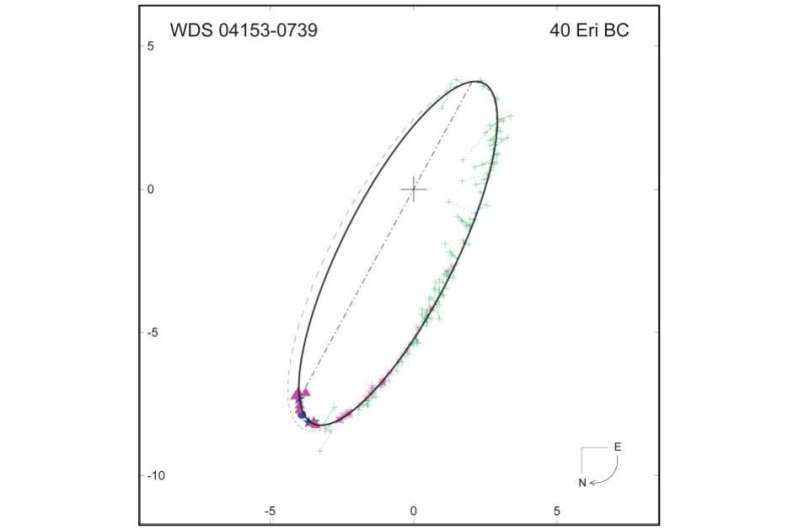Astronomers resolve mystery of white dwarf's mass

New observations of the white dwarf/red dwarf binary star 40 Eridani BC by astronomers at the U.S. Naval Observatory (USNO) have revealed new, definitive values for the orbital period and masses of the components of this interesting stellar pair. A paper describing the observations and the results by Dr. Brian Mason, Dr. Bill Hartkopf, and intern Korie Miles has been accepted for publication in the Astronomical Journal.
40 Eridani BC (also known as Omicron-2 Eridani) is a well-known double star that has been observed by many astronomers since its properties were first accurately measured by William Rutter Dawes in 1867. It is located about 16 light-years from Earth and is easily observed in amateur telescopes. Measuring the period of the component stars as they orbit their center of mass and knowing their distance allows astronomers to compute their combined masses. As more observations were recorded over the decades, the characteristics of the stars' orbits were computed, allowing a first determination of the stars' combined masses. It quickly became apparent that 40 Eridani BC was an unusual system.
By combining the computed orbits with spectrographic data and the stars' nearby location, it was found that the brighter component was a "white dwarf," the highly compressed remnant of a star that has collapsed after exhausting its nuclear fuel. The fainter component is a "red dwarf," a low-luminosity, low-mass star that will feebly shine for hundreds of billions of years. While red dwarf stars may be the most prevalent types of "normal" stars in the galaxy, white dwarf stars are comparatively rare. 40 Eridani B is the second-brightest white dwarf known and is the only one that can easily be seen in backyard telescopes. It was also the first white dwarf star to have its mass determined by measuring its gravitational redshift, a characteristic of very dense objects.
Utilizing a technique called "speckle interferometry," Dr. Mason and his colleagues observed 40 Eridani BC over the course of six nights in early 2017 using the USNO's 66-cm (26-inch) "Great Equatorial" refractor telescope, purchased in 1873. The lens on this telescope was used by astronomer Asaph Hall to discover the moons of Mars, Phobos and Deimos, in 1877. Re-mounted at its present site in 1893, the telescope has been used for measuring double stars since that time.
Prior orbit calculations for 40 Eridani BC yielded a discrepancy between the mass of the white dwarf component derived from its orbital motion and that determined by its gravitational redshift.
"Due to the long period of most visual binaries and the understandable impatience of calculators," says Dr. Mason, "orbits are often calculated when they 'can' be and not necessarily when they 'should' be."
The newly reported observations by Dr. Mason et al. and archival observations allow a new orbit to be calculated which resolves that discrepancy. The new observations indicate that the components of 40 Eridani BC circle each other with a period of 230.29 +/- 0.68 years, about 20 years less than the previous determination. The mass of the white dwarf component is now believed to be 0.573 +/- 0.018 solar masses, about 0.15 solar mass greater than the previous estimate and closer to the result obtained by gravitational redshift.
Dr. Mason notes, "Now that the mass from the orbit matches that from the gravitational redshift, this source of consternation has gone away and it is not necessary to invoke other more exotic solutions to the problem. Patience is a virtue."
More information: Binary Star Orbits. V. The Nearby White Dwarf - Red Dwarf pair 40 Eri BC, Brian D. Mason, William I. Hartkopf & Korie N. Miles, 2017, to appear in the Astronomical Journal arxiv.org/abs/1707.03635
Journal information: Astronomical Journal
Provided by U.S. Naval Observatory




















